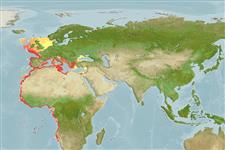Common names from other countries
Environment: milieu / climate zone / depth range / distribution range
Οικολογία
Θαλασσινό(ά) βαθύβιο(ς); εύρος βάθους ? - 700 m (Ref. 35388), usually 150 - 400 m (Ref. 26999). Deep-water; 60°N - 23°S, 18°W - 36°E
Eastern Atlantic: north of British Isles and North Sea to Walvis Bay, Namibia, including Madeira and the Mediterranean (excluding the Black Sea).
Length at first maturity / Μέγεθος / Βάρος / Age
Maturity: Lm ?, range 30 - ? cm
Max length : 60.0 cm TL αρσενικό/απροσδιόριστο; (Ref. 3397); common length : 30.0 cm TL αρσενικό/απροσδιόριστο; (Ref. 4697); μεγ. αναφερόμενη ηλικία: 7 έτη (Ref. 7008)
Ραχιαίες άκανθες (συνολικά) : 9 - 10; Μαλακές ραχιαίες ακτίνες (συνολικά) : 15 - 16; Εδρικές άκανθες: 0; Μαλακές εδρικές ακτίνες: 15 - 16.
Found on sand and mud bottoms (Ref. 27121). Feeds on shrimps and crabs (Ref. 27637).
Life cycle and mating behavior
Maturities | Αναπαραγωγή | Spawnings | Egg(s) | Fecundities | Προνύμφες
Richards, W.J. and V.P. Saksena, 1990. Triglidae. p. 680-684. In J.C. Quero, J.C. Hureau, C. Karrer, A. Post and L. Saldanha (eds.) Check-list of the fishes of the eastern tropical Atlantic (CLOFETA). JNICT, Lisbon; SEI, Paris; and UNESCO, Paris. Vol. 2. (Ref. 3687)
IUCN Red List Status (Ref. 130435)
CITES (Ref. 128078)
Not Evaluated
Threat to humans
Harmless
Human uses
αλιεία: περιορισμένης εμπορικότητας
Εργαλεία
Special reports
Download XML
Διαδικτυακές πηγές
Estimates based on models
Preferred temperature (Ref.
115969): 8.5 - 14.9, mean 13.1 (based on 252 cells).
Phylogenetic diversity index (Ref.
82804): PD
50 = 1.0000 [Uniqueness, from 0.5 = low to 2.0 = high].
Bayesian length-weight: a=0.00832 (0.00693 - 0.00998), b=3.00 (2.95 - 3.05), in cm Total Length, based on LWR estimates for this species (Ref.
93245).
Τροφικό Επίπεδο (Ref.
69278): 3.7 ±0.0 se; based on diet studies.
Ελαστικότητα (Ref.
120179): Μεσαίο(α), ελάχιστος χρόνος για διπλασιασμό πληθυσμού 1,4 - 4,4 έτη (K=0.11-0.21; tmax=8).
Fishing Vulnerability (Ref.
59153): High vulnerability (63 of 100).
Climate Vulnerability (Ref.
125649): Low vulnerability (13 of 100).
